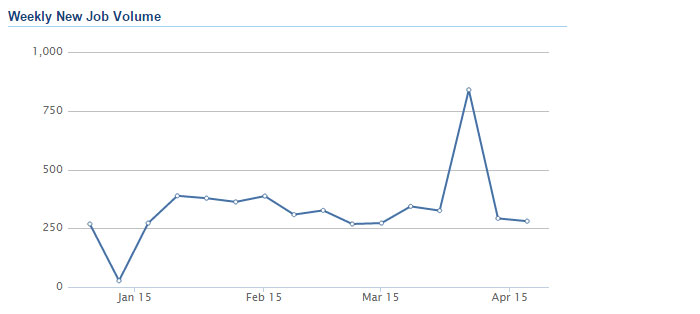HR, and specifically recruiting, is increasingly being asked to use big data sets to be more consultative. Instead of just going on gut-instinct and past experiences, talent acquisition teams are using statistics and trends to be strategic in how they find talent and which potential candidates will make the best fit. According to our own data, there were 17% more HR jobs requiring the ability to evaluate big data in 2014 than there were in 2013.
Demand so far in 2015 has grown even faster, showing HR professionals are more frequently being called on to use big data in their everyday workflow.
Hiring Demand for “Big Data” Skills in HR Jobs – March 2013 to March 2015:

So how is big data used in talent management? Here are our top five ways your HR team should be bringing data to the conversation.
1. In recruiting, data should be used initially during any strategic planning meeting that looks at talent. By looking at the competition, salary, availability of talent, time-to-fill, and overall recruiting conditions for both your job and local/industry averages, you can compare your job and others.
Is your salary lower than average? Do you require a combination of skills that is harder to find? How many other companies are hiring for similar talent right now? All of these questions will help you determine if conditions in your local area will make hiring easier or harder. If you can alleviate some of the difficulty by recruiting elsewhere or modifying your strategy, you can communicate this to the Hiring Manager and set expectations correctly.
2. Many HR teams are beginning to use data for training and development plans, as well. If you know skills are in high demand and hiring for them is likely to be difficult, building training plans will prepare your employees for changing technologies and promotions. The same can be said for certification needs. Determine which certifications are needed in your business and develop a plan for your employees to take necessary tests. Work with industry associations and colleges – either brick and mortar or online programs – to provide the needed licenses or certifications.
An example is Associate Chartered Certified Accountants. Professionals with this certification will be hard to find across the UK. However, in London, they are in a shorter supply. Employers in London should take note of this and provide on-the-job training and continuing education for their accounting professionals. They may also want to take special care of employees that do have their accreditation and ensure they are retained within the organization.
Hiring Scale for Associate Chartered Certified Accountants in London, UK

3. Data can also be used for strategic business needs. Are you looking to open a new manufacturing plant or expand offices? Use supply and demand data to determine the best place to locate that office based on how quickly you’ll be able to staff up. Areas with a larger existing workforce will allow you hire up faster and reduce the need to relocate, meaning you can open a new office faster and cheaper.
For example, the Wirral on Merseyside is one of the best options for manufacturing facilities in the UK. There are 10,000 people with manufacturing experience in this area, yet only 15 jobs currently open. You’re likely to be able to hire large numbers of employees in a short period of time based on the availability of talent and minimal competition.
Best Location for Hiring Manufacturing Talent Quickly – Wirral, Merseside

4. HR professionals can use talent data for immense amounts of competitive intelligence. Job ads can predict new product lines, business expansions, and expanding operations. Many times job ads will actually list specific role responsibilities and skills needed in the position. By reading your local and industrial competitions’ job descriptions, you can get an idea of new product lines or technology upgrades. In addition, you can see where your competition is opening new offices.
Are they moving in near your operations? Are you at risk of losing employees if they do? Tracking hiring demand spikes or declines will give you advanced warning of their intentions. Below is an example of a company’s hiring that spiked one week. More research could show that they opened a new office and posted new jobs.
Hiring Trendline for Cisco

5. Data can be used by HR as an influencer earlier in the business process. For example, if your organization that commonly submits bids, talent market data can be used to determine if you should even submit a proposal. If you win a bid, you’ll likely need to hire employees or contractors, or move your current internal employees to work on the project. Based on supply analysis, will you be able to find the needed talent in the project area? Can you relocate them?
Providing this data up front to project leaders will influence the business’ approach to bidding and how they will fulfill the contract. This could potentially save a lot of difficulty down the road and prevent unsatisfied customers by addressing challenges up front.
Data will continue to be used in the HR function down the road and it will continue to evolve. HR leaders can take pieces of data like the above, and add data from other places to really become influential. For example, when looking to locate an office, take the supply data like in #3 above and add real estate prices and compensation data to come up with a full cost of opening a manufacturing plant by square foot. Doing this for several cities will give you real numbers that can help you determine the cheapest place to open that office.
However, it’s critical that HR educates other parts of the organization on the data that’s available and how to use is. HR leaders can bring and present data to meetings, explain it, and influence business strategy. By doing this, leadership will see HR as a strategic partner, rather than an administrative or back-end function.







2 responses
Brilliantly written article.
Brilliantly written article. Pretty much served the purpose of better clarity on big data usage by HR professionals.
Meredith, very interesting
Meredith, very interesting article. Many uses of big data have a measurable positive impact on outcomes and productivity. Areas such as record linkage, graph analytics deep learning and machine learning have demonstrated being critical to help fight crime, reduce fraud, waste and abuse in the tax and healthcare systems, combat identity theft and fraud, and many other aspects that help society as a whole. It is worth mentioning the HPCC Systems open source offering which provides a single platform that is easy to install, manage and code. Their built-in analytics libraries for Machine Learning and integration tools with Pentaho for great BI capabilities make it easy for users to analyze Big Data. Their free online introductory courses allow for students, academia and other developers to quickly get started. For more info visit: hpccsystems.com